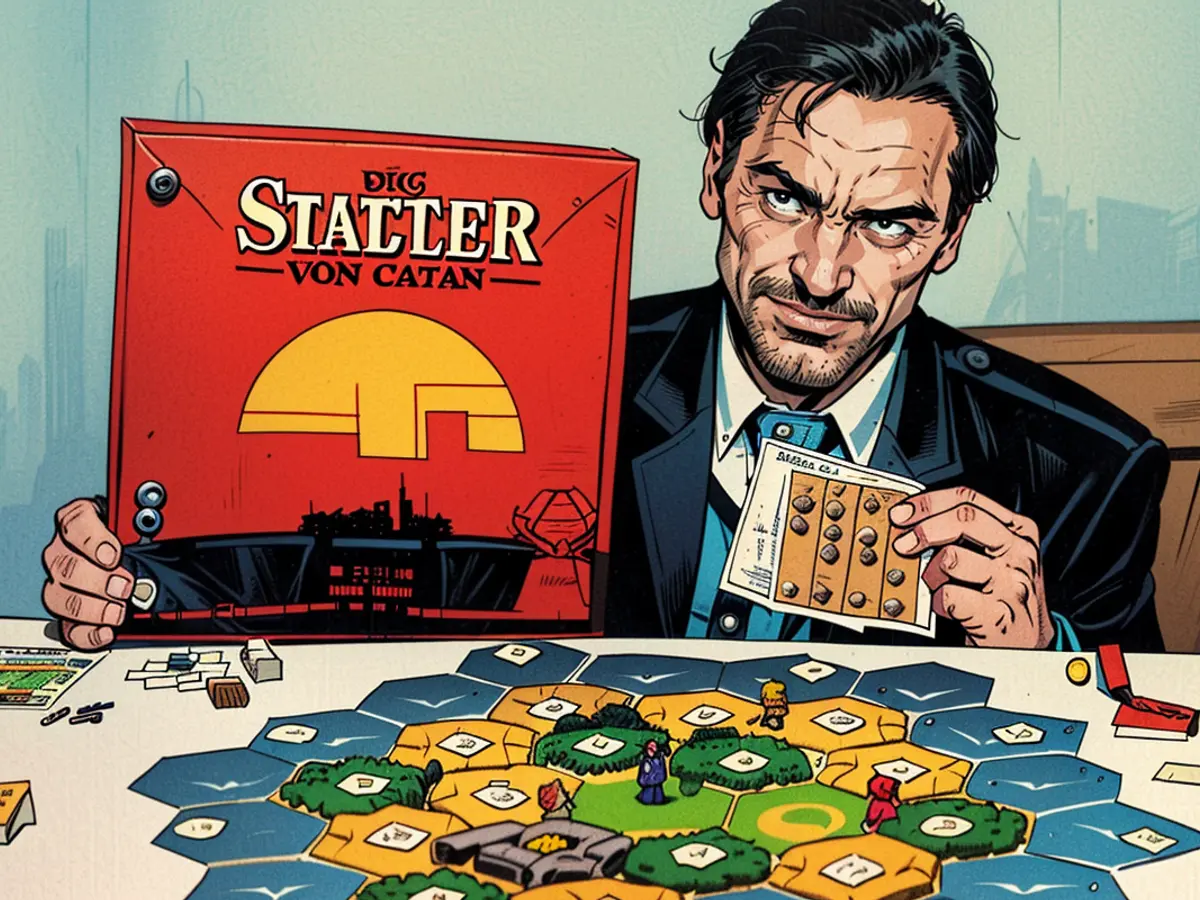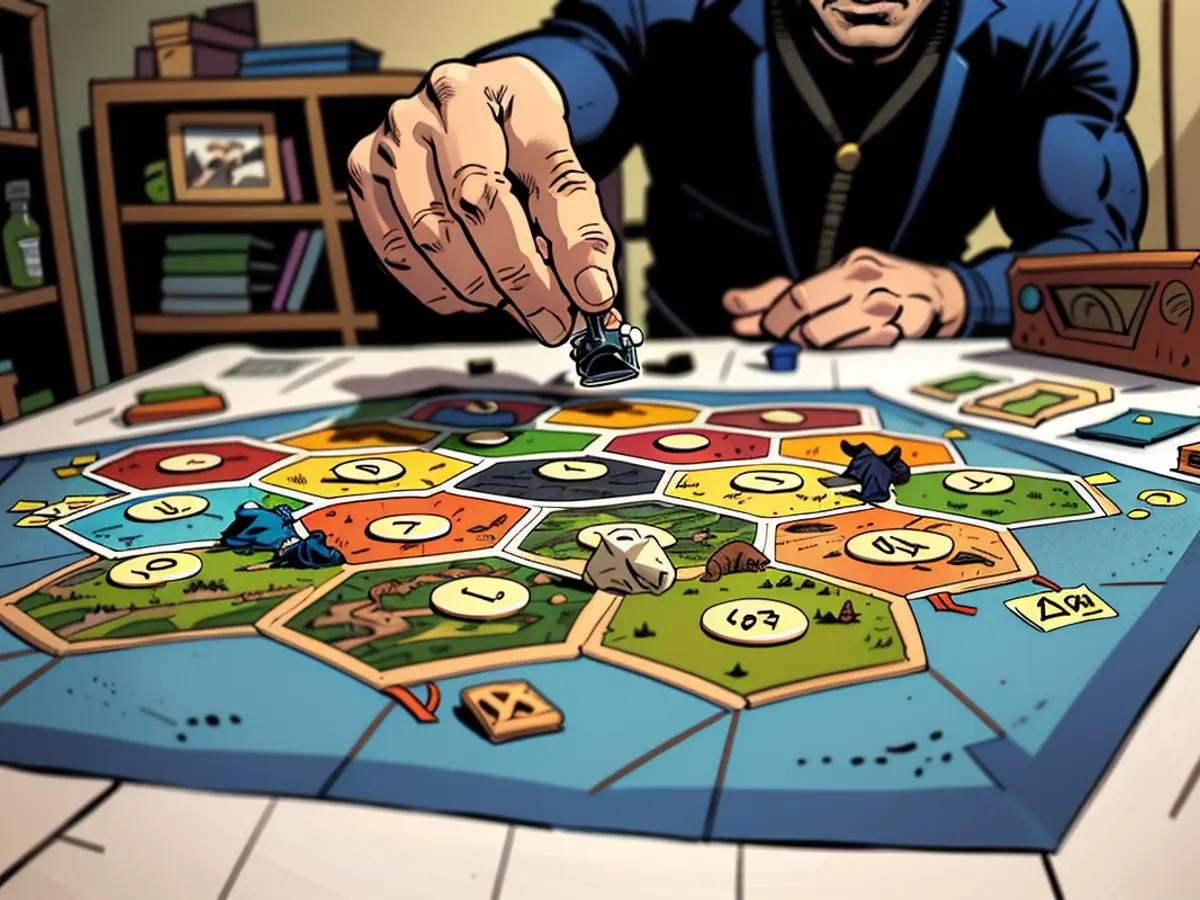The beloved board game underwent multiple transformations to reach this point.
The connection between fathers and sons is playfully exemplified through the late Klaus Teuber, a renowned creator of board games.
In 1995, Teuber launched Catan in Germany (known then as The Settlers of Catan), which eventually became one of the most widely-loved games across the world. One notable memory the brothers share is testing an early iteration of a Catan expansion with their parents about a decade ago. Unfortunately, the game was so challenging that their mother left the table to do laundry.
This story of family bonding around a board game is universally relatable - whether it entails Parcheesi, monopoly, or lewd rounds of Cards Against Humanity at parties.
Aside from its widespread appeal, the board game industry is a thriving market, with 19% of the global population indulging as enthusiasts and the sector earning nearly $17 billion in 2023. Stores like large retailers and bookstores devote entire shelves to these games, and some cities even boast dedicated board game cafes.
Tabletop games, encompassing titles like Risk and Clue, dominate the genre, closely followed by card and dice games such as Uno and Pandemic: The Cure. Role-playing games, such as the legendary Dungeons & Dragons, also fall under this umbrella.
If you're a passionate board game aficionado or a casual player, have you ever pondered the process behind crafting these beloved cardboard creations?
To commemorate National Board Game Day on April 11, CNN reached out to industry creators, artists, marketers, and publishers for insight into the varied stages of designing, creating, and bringing a game to life.
Cultivating the vision of a board game
Much like a board game itself, devising a game necessitates a combination of creativity and pragmatism at every turn - from brainstorming to playtesting to sourcing supplies and getting the final product into customers' hands.

Patience, Benjamin Teuber emphasizes, is vital.
Having already contributed much to Catan GmbH, the company now led by Benjamin and his brother Guido, Benjamin recognized the importance of storytelling in game development.
Catan is a strategy game involving resource collection (wood, ore, grain) and empire building that's spawned countless expansions and variations. With a board depicting resource tiles, along with cards and models, the game has sold over 45 million copies globally since its 1995 inception.
For Benjamin Teuber, who collaborated with his father Klaus for over ten years on game development, the first step involves penning down potential game concepts. Following this, he contemplates the narrative and mechanics of the game for around a month.
"The story is always the core," he asserts. "If the story is well represented in the mechanics, that's when you start taking notes, which may then lead to computer-generated sketches."
Afterward, he prints a prototype of the game on paper to test it further.
Realizing the story's potential
Creating Wyrmspan, launched by Stonemaier Games on March 29, differs from the process followed for Catan.

Wyrmspan is a spinoff of the celebrated Wingspan but tasks players with developing caves for dragons, rather than inviting birds to prepared habitats on your board.
A dragon-themed spinoff was among Wingspan's most requested offshoots, says Wyrmspan's designer, Connie Vogelmann.
When Jamey Stegmaier, co-founder of Stonemaier, sought Vogelmann to devise the game, Vogelmann's first step was acquiring Elizabeth Hargrave's consent, who acts as a developer for Wyrmspan.
Since Vogelmann had a pre-existing game system, the development process for Wyrmspan was somewhat expedited compared to the usual duration.
"It took roughly a year or a year and a half to establish the core gameplay," remarks Vogelmann. For context, Catan: New Energies, expected in May, faced a decade-long development period before its revival this year.
Presenting a unique challenge, Vogelmann aimed to maintain a balance between paying homage to Wingspan and differentiating Wyrmspan.
"In some respects, it was easier, as it supplied constraints for the game," she explains. "Yet, in other ways, it was tremendously more difficult."
Throughout their participation in Wyrmspan's development, Vogelmann and Hargrave experimented with various game elements. For a while, Wyrmspan was a so-called bag-building game where player actions are influenced by tokens added to or removed from a sack. Later, the incorporation of Wingspan's player mats into Wyrmspan enabled its ultimate success. "That was the missing secret sauce," Vogelmann recalls.

After creating a preliminary design for a board game, designers commonly transition into the playtesting phase.
Jane Hoffacker, CEO of Incredible Dream, does this by printing out the game on paper. Before co-founding Incredible Dream in 2020, she had experience in production and video games. She began her career at Activision with Guitar Hero and later joined Riot Games, where she became an executive producer for the Emmy-winning Netflix animated series "Arcane," based on League of Legends.
"I brought a video game mindset to board games," says Hoffacker. "Which was like, 'we need to go through a thousand steps to get to whatever.'"
However, Hoffacker soon discovered that this wasn't the case. "I could literally print it out on my printer and take it to a local game cafe and sit down with strangers who were willing to test with me in person," she notes. These paper prototypes help determine the game's mechanics before they are finalized.
Hoffacker and the Incredible Dream team also attend game conventions to showcase their prototypes, where long lines of people eagerly await the chance to test the game. These playtesting sessions help refine the mechanics, occasionally leading to significant changes or even starting over from scratch.
Designer Hayley Vogelmann, creator of Wyrmspan, prefers a rapid-fire approach to prototyping. "I'm a mechanism-first designer, but playtesting really clarifies the mechanics," she says. "It's hard to envision how things will play out in practice. It can be perfect in your head, but when you get to the table, it falls apart."
Iteration is crucial, and Vogelmann is committed to constant improvement. Benjamin Teuber, developer of Catan, agrees, but playtesting differs among board game studios.
Teuber notes, "When playtesting with just one other person, it usually fails entirely." After this, he decides whether to continue development or not. "In some cases, you have to accept that it just didn't work, and let it go."

Bringing the game to life
Once the mechanics and design of the game are established, developers must produce a tangible, final product for players to enjoy.
This process entails finalizing the artwork and securing manufacturers to produce the game's components. Crowdfunding platforms have become more popular for independent board game studios, offering special upgrades to enhance certain aspects of the game.
"We spent a lot of time getting the components right," Hoffacker explains. This includes working with a publisher, such as Stonemaier, to finalize the elements and save on costs through existing partnerships.
Tactile elements, like the soft velvet feel of Incredible Dream's upcoming game A Gentle Rain, can have a big impact on the player experience. "The tiles have this soft velvet feel," Hoffacker says. "Then there are these tokens made from wood, which adds a different tactile sensation."
For the mass consumer market, another version of A Gentle Rain will be produced with 3D-sculpted plastic flowers instead of wooden tokens, destined for chain stores like Target.
Campardou, the artist for Wyrmspan, merged the design process with the development, simplifying the timeline. She hand-painted everything for the game in watercolor, from the box to the board backgrounds and cards, totaling 75 unique cave cards and 183 unique dragons. However, Campardou faced challenges, taking a year and a half to complete. "When doing 200 of anything," she says, "if each takes one day or five days, that's the difference between a 2024 or a 2026 release date."
Although I didn't participate in the actual design process, I had to comprehend how all the puzzle pieces were connected, states Campardou. For the dragons, Connie and I collaborated closely to ensure their categorization matched their characteristics, such as their dominant color, size, and family.

Benjamin Teuber reveals an often overlooked aspect of the game industry - the expenses associated with each component. "The final price of a game is way higher than most people realize," he explains. "A small token or dice can add 50 cents to the overall cost... we continuously attempt to strike the right balance between appealing and affordable materials."
If, however, the game is targeted towards a broader, mainstream audience, developers must be extra mindful of the price. "These individuals simply seek a momentary distraction" explains Kelli Schmitz, Catan Studio's Brand Development Director, who works on Catan's English-language marketing plan. "The avid gamer, on the other hand, is much less price sensitive. They understand that the cost encompasses not just the components themselves but also the developers' talent and the time spent creating the game."
Once suppliers are selected, the parts are manufactured, and the boxes are assembled, the global delivery of the games can take anywhere from six to eight months, depending on the location of the suppliers and the chosen freight company.
The initial Catan US release consisted of 5,000 units, manufactured in a garage in Skokie, Illinois, nearby the airport, according to Guido Teuber.
Guido Teuber reflects on his father's (Klaus Teuber) method of game design and development. "My dad always valued attractive prototypes," Guido explains. "He invested so much time and money into crafting these extraordinary prototypes. If they didn't work out, we'd give him a tough time. He knew he needed our full attention and involvement."
Otherwise, Benjamin would peruse his Mickey Mouse magazines, Guido would play his guitar, and their mother would begin discussing her daily chores - like doing two loads of laundry.
"The Mickey Mouse magazine - this is how the tale goes - served as my (Klaus') gauge of my attention," Benjamin Teuber recounts. "If I began perusing it during the game, he realized he had to return to the basement and continue."
The board game the family played that day a decade ago did evolve into something, admits Benjamin Teuber, but it took numerous adjustments to reach that point.

Read also:
The Teuber brothers, including Benjamin, have been instrumental in the evolution of Catan, a beloved game globally.
In the US, the initial release of Catan consisted of 5,000 units, manufactured near Chicago, where the family often played their prototypes, engaging in friendly competition and brainstorming sessions.








